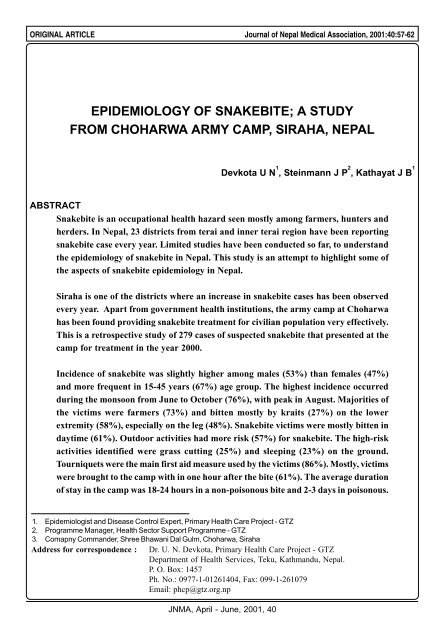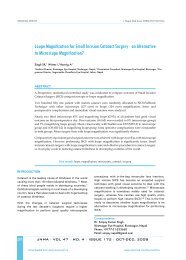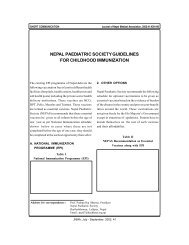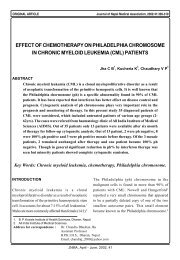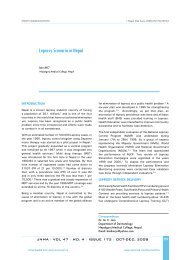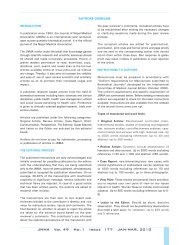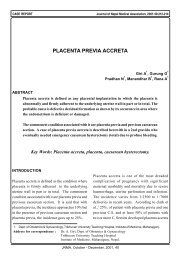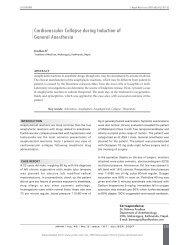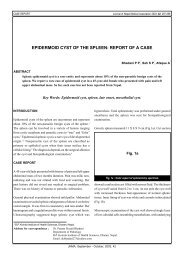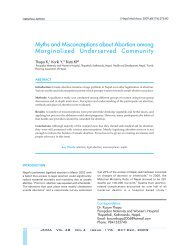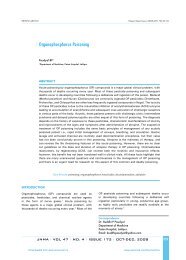JNMA (138) Final - Journal of Nepal Medical Association
JNMA (138) Final - Journal of Nepal Medical Association
JNMA (138) Final - Journal of Nepal Medical Association
Create successful ePaper yourself
Turn your PDF publications into a flip-book with our unique Google optimized e-Paper software.
ORIGINAL ARTICLE <strong>Journal</strong> <strong>of</strong> <strong>Nepal</strong> <strong>Medical</strong> <strong>Association</strong>, 2001:40:57-62<br />
EPIDEMIOLOGY OF SNAKEBITE; A STUDY<br />
FROM CHOHARWA ARMY CAMP, SIRAHA, NEPAL<br />
Devkota U N 1 , Steinmann J P 2 , Kathayat J B 1<br />
ABSTRACT<br />
Snakebite is an occupational health hazard seen mostly among farmers, hunters and<br />
herders. In <strong>Nepal</strong>, 23 districts from terai and inner terai region have been reporting<br />
snakebite case every year. Limited studies have been conducted so far, to understand<br />
the epidemiology <strong>of</strong> snakebite in <strong>Nepal</strong>. This study is an attempt to highlight some <strong>of</strong><br />
the aspects <strong>of</strong> snakebite epidemiology in <strong>Nepal</strong>.<br />
Siraha is one <strong>of</strong> the districts where an increase in snakebite cases has been observed<br />
every year. Apart from government health institutions, the army camp at Choharwa<br />
has been found providing snakebite treatment for civilian population very effectively.<br />
This is a retrospective study <strong>of</strong> 279 cases <strong>of</strong> suspected snakebite that presented at the<br />
camp for treatment in the year 2000.<br />
Incidence <strong>of</strong> snakebite was slightly higher among males (53%) than females (47%)<br />
and more frequent in 15-45 years (67%) age group. The highest incidence occurred<br />
during the monsoon from June to October (76%), with peak in August. Majorities <strong>of</strong><br />
the victims were farmers (73%) and bitten mostly by kraits (27%) on the lower<br />
extremity (58%), especially on the leg (48%). Snakebite victims were mostly bitten in<br />
daytime (61%). Outdoor activities had more risk (57%) for snakebite. The high-risk<br />
activities identified were grass cutting (25%) and sleeping (23%) on the ground.<br />
Tourniquets were the main first aid measure used by the victims (86%). Mostly, victims<br />
were brought to the camp with in one hour after the bite (61%). The average duration<br />
<strong>of</strong> stay in the camp was 18-24 hours in a non-poisonous bite and 2-3 days in poisonous.<br />
1. Epidemiologist and Disease Control Expert, Primary Health Care Project - GTZ<br />
2. Programme Manager, Health Sector Support Programme - GTZ<br />
3. Comapny Commander, Shree Bhawani Dal Gulm, Choharwa, Siraha<br />
Address for correspondence : Dr. U. N. Devkota, Primary Health Care Project - GTZ<br />
Department <strong>of</strong> Health Services, Teku, Kathmandu, <strong>Nepal</strong>.<br />
P. O. Box: 1457<br />
Ph. No.: 0977-1-01261404, Fax: 099-1-261079<br />
Email: phcp@gtz.org.np<br />
<strong>JNMA</strong>, April - June, 2001, 40
58 Devkota, Steinmann, Kathayat : Epidemiology <strong>of</strong> Snakebite a study from ...<br />
INTRODUCTION<br />
Globally more than 3,500 species <strong>of</strong> snakes have been<br />
identified <strong>of</strong> which about 500 are poisonous. In <strong>Nepal</strong>,<br />
a total <strong>of</strong> 75 species <strong>of</strong> snakes have been reported so<br />
far, in which 20 are poisonous. The most commonly<br />
found poisonous snakes from terai and inner terai<br />
includes, 4 species <strong>of</strong> krait, 3 species <strong>of</strong> cobra, 9 species<br />
<strong>of</strong> viper, 1 species each <strong>of</strong> coral snake, Himalayan pit<br />
viper, mountain pit viper and Russel’s viper. The<br />
distribution <strong>of</strong> these poisonous snakes depends largely<br />
on the geography and climate. The Himalayan pit<br />
viper has been found up to an altitude <strong>of</strong> 5,000 meters<br />
whereas the pit vipers inhibit wooded mountain slopes<br />
below 3,000 meters. The species <strong>of</strong> krait are found<br />
below 2,000 meters while the species <strong>of</strong> cobras are<br />
confined to the terai. 1,3<br />
Snakebite is an occupational health hazard seen<br />
most among farmers, hunters, and herders in<br />
tropical and sub-tropical countries. In <strong>Nepal</strong>, 23<br />
districts from terai and inner terai region have been<br />
reporting snakebite cases every year. In <strong>Nepal</strong>, the<br />
exact morbidity and mortality from snakebite is<br />
very difficult to estimate due to lack <strong>of</strong> reliable data.<br />
Records <strong>of</strong> snakebite victims treated by traditional<br />
methods are lost to the <strong>of</strong>ficial statistics and hospital<br />
records is the only source <strong>of</strong> information <strong>of</strong> most<br />
snakebite reported in <strong>Nepal</strong>. It has been estimated<br />
that more than 20,000 cases <strong>of</strong> snakebite with 1000<br />
deaths occur every year in <strong>Nepal</strong>. 1 In a study a total<br />
<strong>of</strong> 3,225 snakebite cases with 144 deaths for the<br />
period 1980-85 have been reported (case fatality<br />
4.5%). 2 In <strong>Nepal</strong>, the available data on snakebite<br />
has shown a definite seasonal pattern with the<br />
highest incidence during the monsoon from June<br />
to October, with a peak in August. Due to chronic<br />
shortage <strong>of</strong> anti snake venom (ASV) in government<br />
hospitals and strong belief in traditional remedies<br />
most victims <strong>of</strong> snakebite prefer to go to“Dhami”or<br />
“Jhankri”. Only when the symptoms deteriorate<br />
then the victims are brought to hospital but many<br />
are thought to die on the way.<br />
The Bhawani Dal Gulm (A Royal <strong>Nepal</strong> Army<br />
Company) is situated on the East–West Highway<br />
in Chandra-Ayodhayapur village development<br />
committee at Choharwa in Siraha district. Usually<br />
the medical facilities in the Royal <strong>Nepal</strong> Army are<br />
restricted to the army personnel and their families<br />
only. But considering the severity <strong>of</strong> the snakebite<br />
problem in the district, the Choharwa Army Camp<br />
(CAC) have been providing snakebite treatment<br />
facility for civilians since 1997.<br />
MATERIALS AND METHODS<br />
A total <strong>of</strong> 279 case files <strong>of</strong> snakebite victims with a<br />
history <strong>of</strong> suspected snakebite during the period<br />
January to December 2000 were reviewed. Necessary<br />
data and information on snakebite victims were<br />
extracted from the snakebite register available at<br />
Choharwa Army Camp (CAC) treatment center. All<br />
the data were analyzed for the epidemiological<br />
features <strong>of</strong> snakebite with details <strong>of</strong> age, sex,<br />
occupation, biting sites, location <strong>of</strong> bite, activities<br />
carried out during biting, seasonal variation etc.<br />
RESULTS<br />
The study has revealed that a total <strong>of</strong> 279 cases <strong>of</strong><br />
snakebite were treated in Choharwa army camp<br />
during January to December 2000. Based on the<br />
estimated service catchment area population (65,000<br />
population) <strong>of</strong> Choharwa army camp, the incidence<br />
rate <strong>of</strong> snakebite is 4.3/1,000 population. It is found<br />
that the snakebite cases were almost equally<br />
distributed in both the sexes although, males have<br />
shown slightly higher proportion. There were 53%<br />
(N=147) male and 47% (N=132) female. When age<br />
was considered it was found that all the age groups<br />
were the victims <strong>of</strong> snakebite and ranged from 2 to<br />
80 years with mean age <strong>of</strong> 26 years. The age group<br />
between 15-45 years constituted the major group <strong>of</strong><br />
snakebite victims (67%) (Fig. 1). The next age group<br />
found common was 10-14 years (23%). These figures<br />
supplement the results published elsewhere. 1<br />
<strong>JNMA</strong>, April - June, 2001, 40
Devkota, Steinmann, Kathayat : Epidemiology <strong>of</strong> Snakebite a study from ... 59<br />
No. <strong>of</strong> Cases<br />
70<br />
60<br />
50<br />
40<br />
30<br />
20<br />
10<br />
0<br />
Fig. 1 Snakebite cases by age groups, CAC, Siraha, 2000<br />
2<br />
23<br />
45 yrs<br />
Results have also shown that occupation has an<br />
important role in snakebite. Among the total cases<br />
a large proportion (73%) <strong>of</strong> the victims were farmers<br />
while rest (27%) were students, shopkeepers,<br />
teachers and carpenters (Fig. 2). These figures<br />
Fig. 2 Snakebite cases by occupation, CAC, Siraha, 2000<br />
No. <strong>of</strong> Cases<br />
70<br />
60<br />
50<br />
40<br />
30<br />
20<br />
10<br />
0<br />
18<br />
Farmer<br />
63<br />
23<br />
13<br />
Student<br />
6 6<br />
Shopkeeper<br />
3 1<br />
10<br />
Teacher<br />
14<br />
67<br />
1<br />
Carpenter<br />
6<br />
19<br />
Not<br />
mentioned<br />
coincide with the results <strong>of</strong> previous study. 3<br />
Analysis <strong>of</strong> the activities performed by the victims<br />
at the time <strong>of</strong> bite revealed that among all activities,<br />
majorities <strong>of</strong> bites occurred while the victims were<br />
engaged in grass cutting (25%) and sleeping (23%)<br />
on ground (Fig.3). Results have also shown that<br />
Fig. 3 Snakebite cases by activities, CAC, Siraha, 2000<br />
No. <strong>of</strong> Cases<br />
25<br />
20<br />
15<br />
10<br />
5<br />
0<br />
Grass<br />
cutting<br />
Sleeping<br />
Toilet<br />
Playing<br />
Indoor<br />
work<br />
Walking<br />
Rice field<br />
7<br />
Others<br />
10<br />
Not<br />
mentioned<br />
working inside the house (10%) and walking<br />
mostly in darkness (15%) were another important<br />
risk activities in snakebite.<br />
8<br />
In contrast to the general belief that snakes mostly<br />
bite at night, the study has shown that most <strong>of</strong> the<br />
cases <strong>of</strong> snakebite occurred during the daytime<br />
(61%) (Fig.4). Although, the percentage <strong>of</strong> bite at<br />
70<br />
60<br />
50<br />
40<br />
30<br />
20<br />
10<br />
0<br />
No. <strong>of</strong> Cases<br />
Fig. 4 Snakebite cases by time <strong>of</strong> day, CAC, Siraha, 2000<br />
60<br />
50<br />
40<br />
30<br />
20<br />
10<br />
0<br />
Day<br />
35<br />
61<br />
57<br />
Night<br />
night was less (39%) it was interesting to observe<br />
that most <strong>of</strong> the poisonous bite (67%) occurred at<br />
night. When location <strong>of</strong> activity was considered it<br />
was found that outdoor activities have more risk<br />
for snakebite compared to indoor activities. It was<br />
observed that 57% <strong>of</strong> the victims were bitten in<br />
outdoor activities in contrast to 35% indoor<br />
activities (Fig. 5). Among the outdoor activities,<br />
Fig. 5 Snakebites by location <strong>of</strong> activity, CAC, Siraha, 2000<br />
Indoor Outdoor Not mentioned<br />
grass cutting (31%) and walking in dark (26%)<br />
constituted the major risk activities. Among indoor<br />
activities, 65% <strong>of</strong> the victims were bitten during<br />
sleeping.<br />
It was found that most <strong>of</strong> the victims were bitten<br />
on the lower extremity (58%), especially on the<br />
leg (48%). In the upper extremity most <strong>of</strong> the cases<br />
were bitten on hand (28%) (Fig.6). Very few cases<br />
were bitten on head and back.<br />
Although, the snakebite cases were reported<br />
throughout the year, the study has clearly shown<br />
39<br />
8<br />
<strong>JNMA</strong>, April - June, 2001, 40
60 Devkota, Steinmann, Kathayat : Epidemiology <strong>of</strong> Snakebite a study from ...<br />
0<br />
5<br />
0<br />
5<br />
0<br />
5<br />
0<br />
5<br />
0<br />
5<br />
0<br />
Fig. 6 Snakebite cases by site <strong>of</strong> bite, CAC, Siraha, 2000<br />
48<br />
28<br />
11<br />
10<br />
3<br />
Finger Hand Foot Leg Others<br />
Although, there were 79 victims who identified the<br />
biting snake as krait and cobra, only 15 victims had<br />
shown features <strong>of</strong> envenomation and were treated with<br />
anti snake venom (ASV). Rests <strong>of</strong> the cases were<br />
managed conservatively with injection tetanus toxoid,<br />
injection dexamethasone and intravenous fluid. A<br />
total <strong>of</strong> 294 vials <strong>of</strong> ASV were used with minimum 1<br />
to maximum 49 vials (average 19.6 vials/case).<br />
that snakebite is a seasonal event. The highest<br />
incidence <strong>of</strong> snakebite occurred during the monsoon<br />
from June to October (76%), with a peak in August.<br />
Thereafter, the snakebite cases gradually reduced<br />
in number and maintained at a lower rate for rest <strong>of</strong><br />
the year (Fig. 7). Similar results were also observed<br />
The average duration <strong>of</strong> stay <strong>of</strong> snakebite victims in<br />
the camp for the treatment was 18-24 hours in a nonpoisonous<br />
bite. Whereas, in a poisonous bite where<br />
ASV was used the average duration <strong>of</strong> stay was 2-3<br />
days. Surprisingly, no death occurred during the<br />
treatment and all the cases were cured and discharged.<br />
25<br />
Fig. 7 Snakebite cases by months, CAC, Siraha, 2000<br />
22<br />
DISCUSSION<br />
No. <strong>of</strong> Cases<br />
20<br />
15<br />
10<br />
5<br />
0<br />
2 2 2<br />
5<br />
7<br />
13<br />
Jan Feb Mar Apr May Jun Jul Aug Sep Oct Nov Dec<br />
by David Warrell in one <strong>of</strong> the studies. 2<br />
Among the total snakebite victims, only 79<br />
claimed to have seen and identified the snakes. It<br />
was found that 27% <strong>of</strong> the victims were bitten by<br />
krait whereas only 1% by cobra. Tourniquet was<br />
found to be the main first aid procedure used by<br />
the victims (86%). Only a small proportion (2%)<br />
used other measures such as incision and sucking<br />
<strong>of</strong> the wound. Twelve percentages <strong>of</strong> the victims<br />
did not use any first aid procedures.<br />
The snakebite victims were brought to the camp as<br />
early as 20 minutes to as late as 5 hours after the bite.<br />
Majorities <strong>of</strong> the victims (61%) were brought to the<br />
camp within one hour after the bite. Only 25% <strong>of</strong> the<br />
victims were brought within ½ hours <strong>of</strong> the bite.<br />
16<br />
13<br />
11<br />
4<br />
3<br />
The age and sex incidence <strong>of</strong> snakebite victims has<br />
clearly shown that certain groups <strong>of</strong> population in<br />
the community are more vulnerable for snakebite.<br />
It has clearly shown that not only the males, but<br />
the females are equally exposed to the risk factors.<br />
Unlikely in the past, now a days woman in the terai<br />
community are more and more exposed in out door<br />
activities thus making themselves more susceptible<br />
for snakebite. In the study, 60% <strong>of</strong> woman were<br />
bitten in outdoor activities, which included grass<br />
cutting, walking in darkness and during defecation<br />
in open field in darkness. Among indoor activity<br />
most <strong>of</strong> the women (25%) were bitten while<br />
sleeping in the night. It is a common practice in<br />
terai to sleep on the ground, particularly woman<br />
due to poor economic condition.<br />
Although, the study has revealed that all the age<br />
groups were the victims <strong>of</strong> snakebite, the adults<br />
between 15-45 years were the main victims <strong>of</strong><br />
snakebite. It could be attributed to the fact that in<br />
most <strong>of</strong> the terai community adults <strong>of</strong> both the sexes<br />
are equally involved in out door activities,<br />
especially during monsoon. Similar results were<br />
<strong>JNMA</strong>, April - June, 2001, 40
Devkota, Steinmann, Kathayat : Epidemiology <strong>of</strong> Snakebite a study from ... 61<br />
also observed in other studies in <strong>Nepal</strong> and India. 1,4<br />
In terai, it is common to find children between 10-<br />
15 years busy in outdoor activities like grass<br />
cutting, grassing cattle, collecting firewood and<br />
working in fields thus exposing them for snakebite.<br />
The high incidence <strong>of</strong> snakebite among farmers, as<br />
shown in the study, once again highlights the fact<br />
that snakebite is an occupational hazard. Grass cutting<br />
has been identified as the most high-risk activity for<br />
snakebite. It could be due to the fact that in terai people<br />
usually collect grass as a fodder in the field, forest,<br />
bamboo bushes, along the pond, river and stream<br />
bank, under bridges etc. where snakes could easily<br />
hide. Walking in dark with out shoes and torchlight<br />
is another high-risk activity mostly encountered with<br />
snakebite in terai. Mostly, snakes come out <strong>of</strong> their<br />
shelter at night in search <strong>of</strong> food. Therefore, sleeping<br />
on ground in rural communities could be another<br />
high-risk activity. The high incidence <strong>of</strong> snakebite<br />
during the daytime corresponds well with the period<br />
<strong>of</strong> maximum outdoor activity, which has also been<br />
observed in earlier studies. 5<br />
The observation that the most frequent biting site<br />
was the lower extremity suggests that in most cases<br />
the snake had been accidentally stamped. 6,7<br />
Although, the cases <strong>of</strong> snakebite were reported all<br />
the year round, the incidence <strong>of</strong> snakebite showed<br />
a distinct seasonal pattern in conformity with earlier<br />
reports. 1,8 The high incidence <strong>of</strong> snakebite was<br />
closely related to monsoon activity, which<br />
compelled the snakes to come out <strong>of</strong> their shelter<br />
and pits due to high humidity and temperature.<br />
The study has shown that large proportions <strong>of</strong><br />
snakebite victims (72%) were unable to identify<br />
the snake. It could be either due to the ignorance<br />
about snakes or poor visibility, as most <strong>of</strong> the<br />
snakebite occurred while cutting grass, walking in<br />
darkness and sleeping in the night. But those who<br />
identified, majority were bitten by krait. The<br />
application <strong>of</strong> tourniquet by majority <strong>of</strong> the victims<br />
(86%) clearly indicates that communities are well<br />
aware <strong>of</strong> the first aid measure in snakebite. But,<br />
the proper technique to use a tourniquet in an<br />
illiterate terai community is questionable.<br />
Mortality and morbidity in snakebite depends largely<br />
on the prompt medical aid and use <strong>of</strong> ASV therapy.<br />
In our study majority (61%) <strong>of</strong> the victims were<br />
brought to the camp with in one hour <strong>of</strong> the bite. It<br />
shows that communities are well aware about the<br />
importance <strong>of</strong> quick medical treatment in snakebite.<br />
Usually bites from poisonous snakes are extremely<br />
rare and about half <strong>of</strong> the bites from poisonous snakes<br />
do not give significant envenomation and only a few<br />
needs ASV treatment. 9 Although, 79 victims<br />
identified the snakes as krait and cobra, only 15<br />
developed features <strong>of</strong> envenomation and treated with<br />
ASV. In the army camp no death was reported and<br />
all the cases were cured and discharged. Cases not<br />
showing the features <strong>of</strong> envenomation were kept under<br />
observation for a period <strong>of</strong> 18-24 hours whereas the<br />
poisonous cases were kept for 3 days before discharge.<br />
CONCLUSION<br />
The study has revealed that the incidence <strong>of</strong><br />
snakebite in the catchment area <strong>of</strong> Choharwa army<br />
camp is very high. This incidence could be reduced<br />
significantly by using certain simple measures in<br />
the community. The community should be made<br />
aware that snakes are very shy, non-aggressive and<br />
always try to avoid humans. They attack only when<br />
they are disturbed or threatened. Poisonous snakes<br />
should never be kept as pets or as performing<br />
animals. 7 Emphasis should be given to use<br />
protective clothing, shoes/boots, long trousers while<br />
walking in dark or in thick vegetation / forest. It is<br />
always wise to carry a torch / flashlight and a stick<br />
at night. If at all possible one should try to avoid<br />
sleeping on the ground. 1 People should always<br />
beware <strong>of</strong> piles <strong>of</strong> wood, logs, boulders, debris and<br />
<strong>JNMA</strong>, April - June, 2001, 40
62 Devkota, Steinmann, Kathayat : Epidemiology <strong>of</strong> Snakebite a study from ...<br />
should not reach into blind holes where snakes<br />
might hide. Always avoid having rubble, rubbish,<br />
termite mounds or domestic animals close to human<br />
dwellings, as all <strong>of</strong> these attract snakes. If possible,<br />
avoid types <strong>of</strong> house construction that will provide<br />
snakes with hiding places (eg. thatched ro<strong>of</strong>, mud<br />
and straw walls with large cracks and cavities).<br />
The community should know the basic first aid<br />
procedures in snakebites. Emphasis should be given<br />
that snakebite can not be treated by traditional<br />
methods and “Dhami’ or “Jhankri” and every case <strong>of</strong><br />
snakebite should be transported as quickly as possible<br />
to a nearest health facility providing ASV treatment.<br />
Since, most <strong>of</strong> the snakebites are non-poisonous and<br />
50% bites from poisonous snakes do not manifest<br />
features <strong>of</strong> envenomation, simple supportive<br />
measures and observations over 24 hours would<br />
serve in most cases. Considering the cost and<br />
availability, ASV should be used quite discretely.<br />
To reduce the morbidity and mortality from<br />
snakebite, an adequate and timely supply <strong>of</strong> ASV<br />
should be made to the hospitals and PHCs where it<br />
is needed. Regular training and follow up on<br />
snakebite management should be provided to the<br />
health personnel including PHCs and health posts.<br />
Standard treatment protocol on snakebite<br />
management should be developed and disseminated.<br />
ACKNOWLEDGEMENT<br />
Our sincere thanks go to the Epidemiology and<br />
Disease Control Division for providing adequate<br />
and timely supply <strong>of</strong> ASV and involving health<br />
personnel <strong>of</strong> the Choharwa army camp in their<br />
regular training programme on snakebite.<br />
We are also thankful to the health personnel <strong>of</strong> the<br />
Choharwa army camp who supported us in using<br />
the format provided them for information collection.<br />
REFERENCES<br />
1. Devkota UN, Steinmann JP, Shah LN. Snakebite<br />
in <strong>Nepal</strong>, A study from Siraha district. <strong>Journal</strong>s <strong>of</strong><br />
the <strong>Nepal</strong> <strong>Medical</strong> <strong>Association</strong>. Vol. 39; 203-209,<br />
2000.<br />
2. Warrell DA, O’Shea M. Snakes and snakebite in<br />
<strong>Nepal</strong>. Tropical Doctor. Vol. 28; 223-226, 1998.<br />
3. Hansdak SG, Lallar KS et. al. A clinicoepidemiological<br />
study <strong>of</strong> snakebite in <strong>Nepal</strong>.<br />
Tropical Doctor. Vol. 28; 223-226, 1998.<br />
4. Hati AK, Mandal M, De MK et. al. Epidemiology <strong>of</strong><br />
snakebite in the district <strong>of</strong> Burdwan, West Bengal.<br />
J Indian Med Assoc. Vol. 90; 145-47, 1992.<br />
5. Swamy Y, Homa M. Snakebite in India. Animal<br />
Plant and Microbial Toxins. India.Toxico, 1976.<br />
6. Currie BJ, Sutherland SK, Hudson BJ, Smith AM.<br />
An epidemiological study <strong>of</strong> snakebite<br />
envenomation in Papua New Guinea. Med J Aust.<br />
Vol. 154; 266-8, 1991.<br />
7. Warrell DA. WHO/SEARO guidelines for the<br />
clinical management <strong>of</strong> snakebites in the<br />
Southeast Asian Region. Vol. 30. 1999.<br />
8. Bewes P, Holmgren G. Snakebite in East and<br />
Southern Africa. Nytt om U-landshalsovard. Vol.<br />
11;4-8,1997.<br />
9. Heap BJ, Cowan GO. The epidemiology <strong>of</strong><br />
snakebite presenting to British military Hospital,<br />
Dharan, during1989. J R Army Med Corps. Vol.<br />
137; 123-5, 1991.<br />
!""!""!<br />
<strong>JNMA</strong>, April - June, 2001, 40


